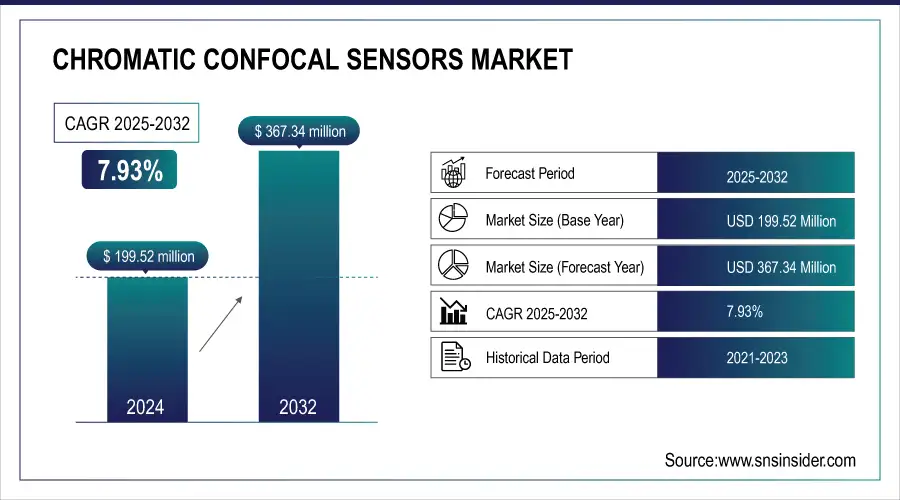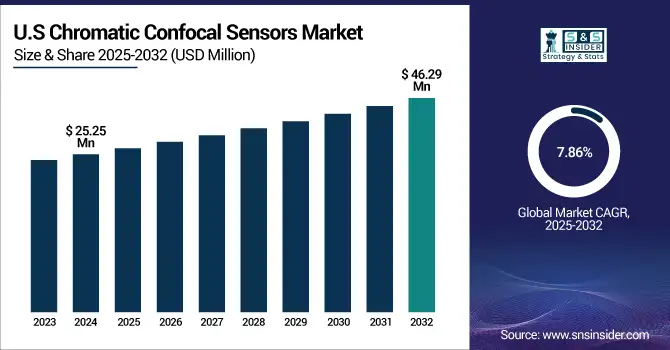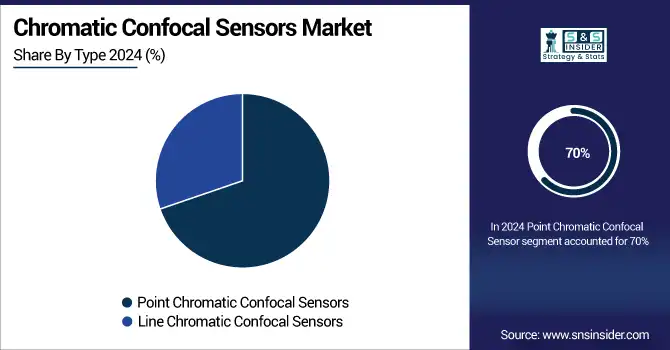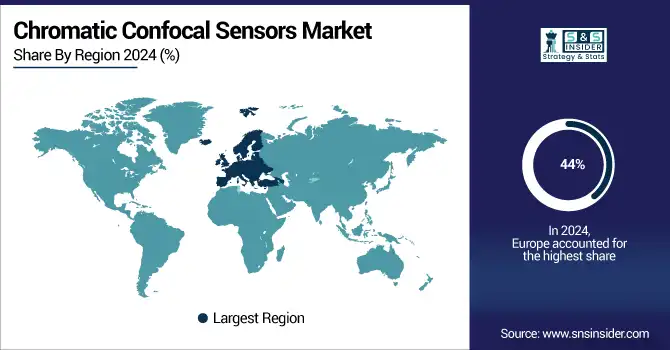Chromatic Confocal Sensors Market Size & Growth:
The Chromatic Confocal Sensors Market size was valued at USD 199.52 Million in 2024 and is projected to reach USD 367.34 Million by 2032, growing at a CAGR of 7.93% during 2025-2032.
The Chromatic Confocal Sensors market is expanding due to the increasing need for precise, non-contact measurement in industrial automation. Because these sensors excel at measuring shiny metals, transparent materials and liquids, they are an ideal choice when online laser sensors reach their limits. They are valuable in industries like semiconductors, electronics, automotive and medical devices, which all require accurate minute measuring. With increasing automation in manufacturing and stringent quality requirements, manufacturing sites are focused on improving inspection and process control, and for this, innovations in chromatic confocal technology are being deployed. Due to their simple handling, compact layout and the possibility to communicate with modern systems, this type of sensors is making a major contribution to the productivity and the quality of the product.
Micro-Epsilon has introduced two new compact confocal controllers IFC2411 and IFC2416, providing high speed, ultra precision, air gap measurement and thickness measurement for automation applications. These controllers provide multilayer functions and improved integration, and are perfect for reflective and transparent surfaces.

To Get more information on Chromatic-Confocal-Sensors-Market - Request Free Sample Report
The U.S Chromatic Confocal Sensors Market size was valued at USD 25.25 Million in 2024 and is projected to reach USD 46.29 Million by 2032, growing at a CAGR of 7.86% during 2025-2032, increasing use of high-precision, non-contact measurement solutions in end user industries such as semiconductor, electronics and medical devices is expected to drive the chromatic confocal sensors market. Progress in automation, quality control, as well as the demand for precise inspection of geometries with varying surface complexity, are driving modest growth of the Chromatic Confocal Sensors market growth until 2032.

Chromatic Confocal Sensors Market Dynamics:
Drivers:
-
Precision Demand Fuels Shift to Laser-Based CNC Tool Measurement Solutions
The rising demand for high-precision, non-contact CNC tool measurement solutions is driving growth in the laser tool setter market. As modern manufacturing increasingly requires tighter tolerances and higher efficiency, industries are shifting from traditional mechanical setters to advanced laser-based systems. These systems have more accurate measurement output, lower maintenance needs and the ability to track tool wear, breakage and spindle performance in real time. It's also their ability to be used in high temerature environment and are not affected by the cutting fluids and chips. Compact, flexible design and multi-use functionality helps to reduce set-up time, downtime and variation. These benefits are driving adoption in industries, A&D, automotive, electronics, and precision engineering, and consequently driving market growth and technology development.
Hypersen has released the HPS-LCA100, China’s first purple laser tool setter, which improves CNC machining accuracy, operating with non-contact, ultra-high resolution measurements. The 405nm laser technology-based device operates up to 200,000 rpm and provides compact and maintenance free stable operation in a rugged, harsh environment.
Restraints:
-
Challenging Integration Leads to Slower Adoption and Higher Implementation Costs in Chromatic Confocal Sensors Market
The chromatic confocal sensors market has been encountering a few obstructions such as difficulty in integrating chromatic confocal sensors with the automation and control foundation. In many cases, a few specialist suppliers which many manufacturers do not have, leading to long implementation times and higher costs, can only do it. Moreover, the necessity for tailoring to meet special industrial requirements can also complicate the deployment. The initial cost of investment for smart sensors and compatible infrastructure, which is an obstacle for the small companies. In addition, sensitivity to extra-environmental factors - air-borne cloud, vibration, temperature variation as dust, etc., - influences the sensor work in some extreme industrial conditions. These issues effectively impede market development by impelling efforts to install chromatic confocal sensor technology to become increasingly difficult and costly in different sectors of industry.
Opportunities:
-
Rising Demand for High-Precision Non-Contact Measurement Across Key Industries
The chromatic confocal sensors market presents significant growth opportunities driven by increasing demand for high-precision, non-contact measurement solutions in industries such as semiconductor manufacturing, automotive, electronics, and healthcare. These sensors also provide special benefits when measuring complex surfaces, transparent materials, multi-layer objects with very high accuracy, fulfilling the high demands on quality control and automation. With increased automation of production processes and more stringent quality requirements expected to drive the market for chromatic confocal sensors. Fostering factors include advances in technology and advances in the industrial landscape that extends usages of the sensors in new markets sets to challenge market potential offered by these sensors, making them an essential tool contributory to enhanced productivity and dependability.
KEYENCE has introduced the LJ-S8000 Series 3D Laser Snapshot Sensor, featuring an internal motor-driven scanning mechanism, eliminating the need for external lighting, lenses, or moving stages. This innovation allows for ultra-high-speed, high-accuracy inline inspections, achieving imaging speeds up to 0.2 seconds and repeatability of 0.3 µm, streamlining setup and reducing costs.
Challenges:
-
Competition from Alternative Technologies Causes Market Share Challenges for Chromatic Confocal Sensors
The chromatic confocal sensors market faces significant challenges due to competition from alternative measurement technologies, such as laser triangulation sensors. The lower cost and easier integration of these alternatives tend to make them a more attractive proposition in applications for which precision demands are not so high. Laser triangulation sensors are very common in applications where lower accuracies are acceptable therefore demand for the more sophisticated and usually costlier chromatic confocal sensors are less. The possible growth for chromatic confocal sensors, particularly in cost-sensitive areas, is therefore limited. This competition drives manufacturers to innovate and to drive cost out, and in the process, to educate the customer on why confocal technology is the right way to go when making high precision reflective or transparent surface measurements.
Chromatic Confocal Sensors Market Segmentation Analysis:
By Type
The Point Chromatic Confocal Sensors segment held a dominant chromatic Confocal Sensors Market share of around 70% in 2024, driven by its exceptional precision and ability to measure a wide range of surfaces, including transparent and reflective materials. Its versatility makes it ideal for complex industrial applications such as electronics, automotive, and semiconductor manufacturing. Additionally, increasing demand for non-contact, high-accuracy measurement solutions to improve quality control and automation further propels the growth of this segment in the chromatic confocal sensors market.
The Line Chromatic Confocal Sensors segment is expected to experience the fastest growth in the chromatic Confocal Sensors Market over 2025-2032 with a CAGR of 12.89%, on account of increasing need for quick and high precision surface measurement in electronics, automotive and other industries. Its speed in acquiring detailed profile data is quite crucial for high-end automation and quality assurance applications.

By Application
The Semiconductor segment held a dominant chromatic Confocal Sensors Market share of around 45% in 2024, owing to high requirement of accurate non contact measuring devices in semiconductor manufacturing. The growing complexity of chip structures and the requirement for very accurate inspection in order to enhance yield and minimize defects have been the main drivers for the implementation of chromatic confocal sensors within this industry.
The 3C Electronics segment is expected to experience the fastest growth in the chromatic Confocal Sensors Market over 2025-2032 with a CAGR of 13.03%, owing to rising demand for compact, high-precision electronic gadgets. Fueling that expansion is demand for high-performance chromatic confocal sensors that can make precise, non-contact measurements that improve quality and productivity in manufacturing within the realms of consumer electronics and our ever-expanding world of smartphones and wearable technologies.
Chromatic Confocal Sensors Market Regional Outlook:
In 2024, the Europe dominated the chromatic Confocal Sensors market and accounted for 44% of revenue share, due to rapid industrial automation adoption, developed manufacturing infrastructure and heavy investment in the semiconductor and electronics industries which in turn increasing demand for accurate and non-contact measurement technologies which helps in operational efficiency and quality of the product across the industries.

Get Customized Report as per Your Business Requirement - Enquiry Now
The chromatic Confocal Sensors market in the U.S. is developing rapidly, is driven by increasing automation in manufacturing, strong semiconductor industry expansion, and rising demand for high-precision, non-contact measurement solutions.
Asia-Pacific is projected to register the fastest CAGR of 9.62% during 2025-2032, because of growing electronics manufacturing, utilization of automation solutions, and huge investments made in semiconductor manufacturing. Growing need for high-definition measurement in automotive, healthcare, and consumer electronics industries contribute to the growth of the market in the region.
In 2024, North America emerged as a promising region in the chromatic Confocal Sensors, because of presence of developed manufacturing industries, increasing utilization of automation & smart devices, and rising investments in semiconductors & electronics sector. This, in turn, leads to the high precision requirement of sensors, which is in turn expected to uplift the regional sensor market.
LATAM and MEA is experiencing steady growth in chromatic Confocal Sensors, Increasing industrial automation, growing electronics manufacturing and surging investments in smart technology infrastructure help to increase demand for precise limn contact measurement solutions across a wide range of applications, which contributes to the growing sales of chromatic Confocal Sensors
Key Players:
The Chromatic Confocal Sensors Companies are Mahr, Zygo, KEYENCE, Hypersen, Micro-Epsilon, SICK, Omron, Precitec, Renishaw, Pomeas, and Others.
Recent Developments:
-
In March 2025, Zygo showcased its next-generation 3D optical profilers, including the ZeGage Pro and NewView 9000, at CONTROL 2025, highlighting advanced non-contact surface metrology solutions for various industries. Their innovations deliver fast, precise measurements essential for semiconductor, optics, automotive, and aerospace sectors.
-
In Jan 2025, Mahr has relaunched its MarSurf CM explorer confocal microscopes, offering fast, precise, and contactless 3D surface measurements with high repeat accuracy. These robust systems serve diverse industries, such as automotive, semiconductors, and medical technology with nanometer-level height resolution.
| Report Attributes | Details |
|---|---|
| Market Size in 2024 | USD 199.52 Million |
| Market Size by 2032 | USD 367.34 Million |
| CAGR | CAGR of 7.93% From 2025 to 2032 |
| Base Year | 2024 |
| Forecast Period | 2025-2032 |
| Historical Data | 2021-2023 |
| Report Scope & Coverage | Market Size, Segments Analysis, Competitive Landscape, Regional Analysis, DROC & SWOT Analysis, Forecast Outlook |
| Key Segments | • By Product (Point Chromatic Confocal Sensors, Line Chromatic Confocal Sensors) • By Application (Semiconductor, 3C Electronics, Glass Industry, Precision Machine Parts, Battery, Others (Medical)) |
| Regional Analysis/Coverage | North America (US, Canada, Mexico), Europe (Germany, France, UK, Italy, Spain, Poland, Turkey, Rest of Europe), Asia Pacific (China, India, Japan, South Korea, Singapore, Australia, Taiwan, Rest of Asia Pacific), Middle East & Africa (UAE, Saudi Arabia, Qatar, South Africa, Rest of Middle East & Africa), Latin America (Brazil, Argentina, Rest of Latin America) |
| Company Profiles | The chromatic Confocal Sensors market companies are Mahr, Zygo, KEYENCE, Hypersen, Micro-Epsilon, SICK, Omron, Precitec, Renishaw, Pomeas and Others. |

